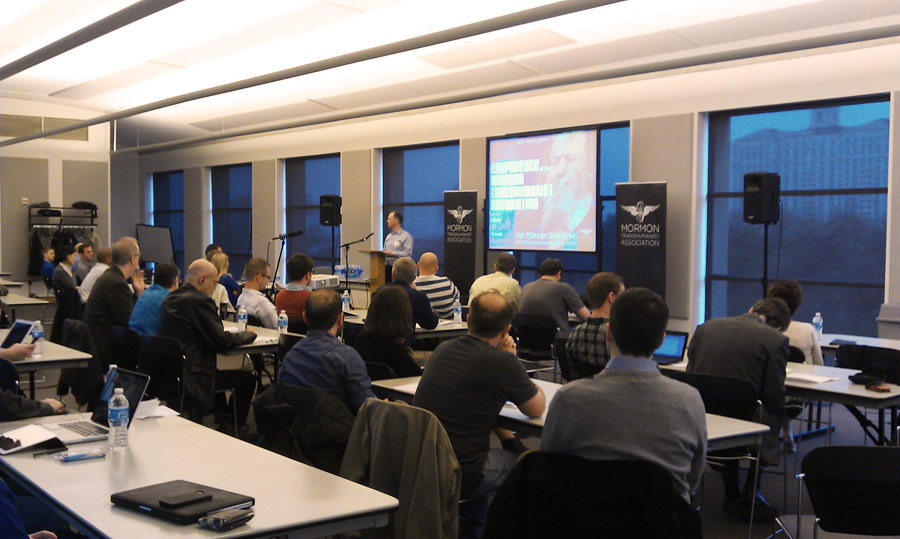Man will become like God, say Mormons and transhumanists in Salt Lake City
April 10, 2013

LIncoln Cannon’s opening address (credit: Giulio Prisco)
Like every year, I attended the yearly conference of the Mormon Transhumanist Association (MTA), on April 6 in Salt Lake City.
It is no mystery that I am very fond of the MTA. I think it represents the best example of successful integration of transhumanist ideas in a mainstream religion, and one of the best transhumanist communities.
Man becoming godlike: belief or heresy?
The Church of Jesus Christ of Latter-Day Saints (LDS), aka Mormon Church, has a concept of boundless elevation and exaltation of Man, through all means including science and technology, until he becomes like God.
Conversely, God was once like Man before attaining an exalted status. “[Mormonism] allows for humans to ascend to a higher, more godlike level,” writes Max More in his introduction to The Transhumanist Reader, “rather than sharply dividing God from Man.”
Mormon transhumanists are persuaded that we will become like God — through science and technology — in a progression without end, and this seems a more faithful interpretation of the teachings of Joseph Smith and a return to the roots of the Mormon religion.
Not all Mormons agree with this transhumanist formulation of their faith but, according to MTA president Lincoln Cannon, it is a correct interpretation of the writings of Joseph Smith, the founder of the Mormon Church, close to the historic and philosophical roots of the LDS doctrine, as shown by the King Follet discourse and the quotes of Smith and other Mormon authorities collected here.
All Mormons are familiar with this aspect of their faith, but many modern Mormons seem to sweep these concepts to the back of their mind, as they do for other controversial issues such as polygamy, promoted (and practiced) by Smith and the founding fathers but frowned upon in modern times.
The tension between the progressive approach of the MTA and the more conservative approach of the Mormon Church at large was especially evident in Brad Carmack’s talk on the rights of LGBT and transgendered persons.
In the first keynote, longevity researcher Aubrey De Grey said that medical Strategies for Engineered Negligible Senescence (SENS) may soon permit eliminating aging, and that failing to do so would be a “sin.” He countered many frequent “ethical” objections to extreme longevity research, showing that life extension is inseparable from healthy aging.
Computational theology?
In the more visionary part of this visionary conference, Alcor’s Mike Perry, author of Forever for All, presented his thoughts on far-future sciences and technologies able to resurrect the dead. In my own talk, I showed how the Problem of Evil — why a benevolent and omnipotent God permits evil and suffering — can be framed and “solved” in terms of the computational physics of a simulated universe.
In the second keynote, renowned historian Richard Bushman, the author of Rough Stone Rolling, a biography of Joseph Smith, put the ideas of the MTA in a Mormon historical perspective. He could hardly be expected to fully endorse the openly transhumanist vision of the MTA, but he departed holding a copy of Ray Kurzweil’s latest book.
As in Max More’s observation, the Mormon Church may be an especially fertile ground for the emergence of a transhumanist religion. But according to musician Micah Redding, similar openings can also be found in mainstream Christianity, albeit in a less explicit form.
Not all speakers were transhumanist-religion-friendly. Carl Teichrib, editor of Forcing Change, criticized transhumanist spirituality from a Christian perspective (see his review of the 2010 conference on Transhumanism and Spirituality), and Peter Wicks criticized the introduction of religious elements in transhumanism.
